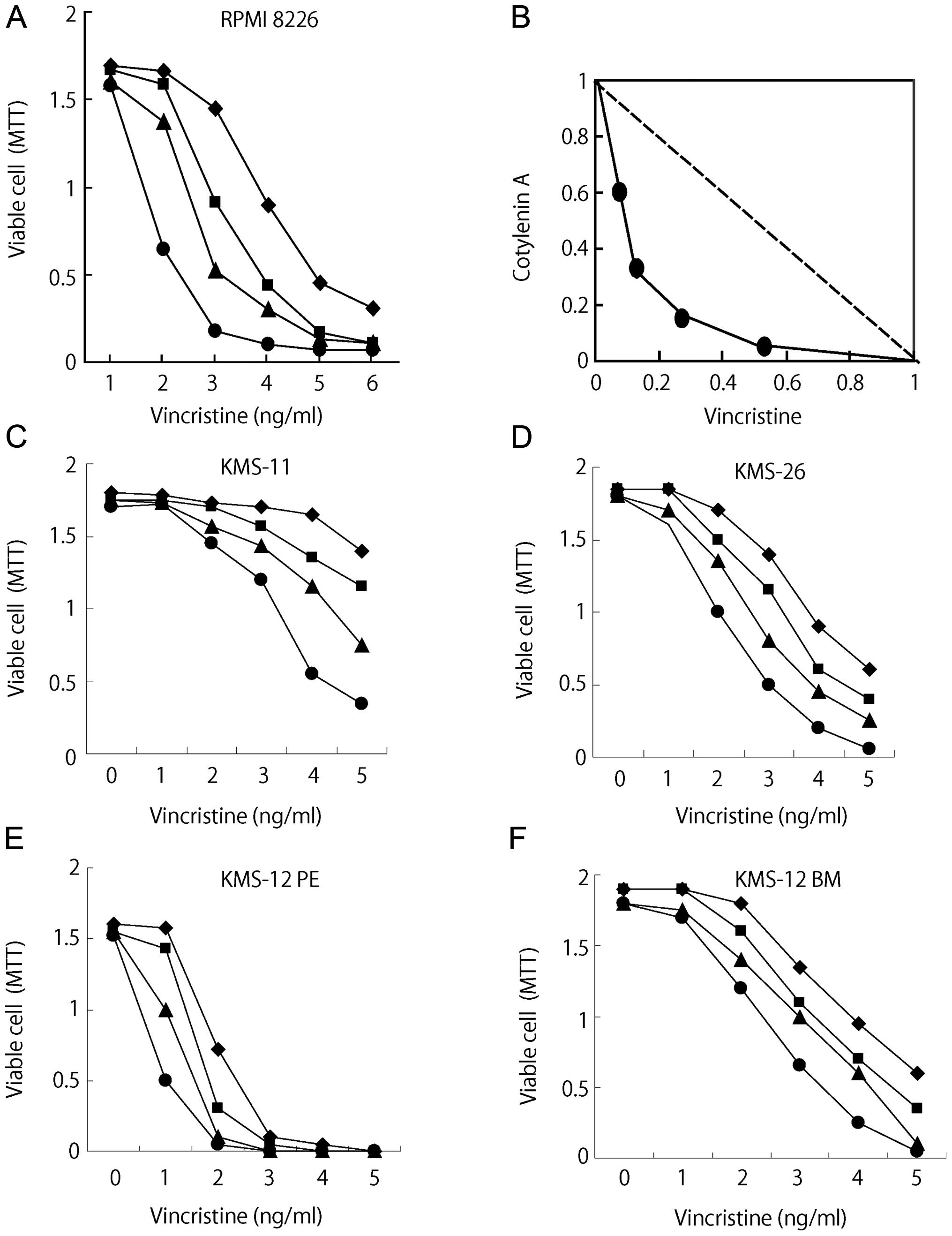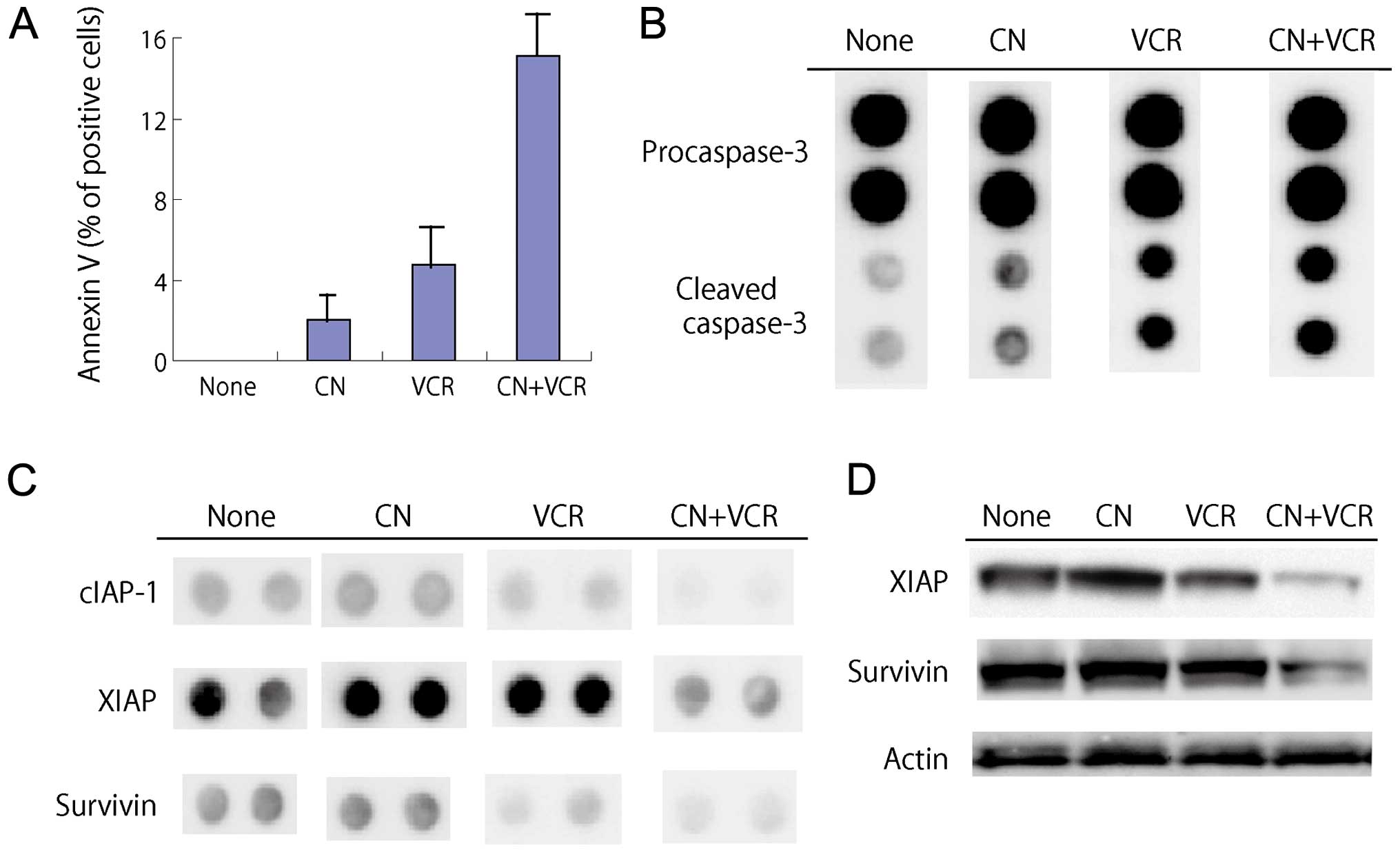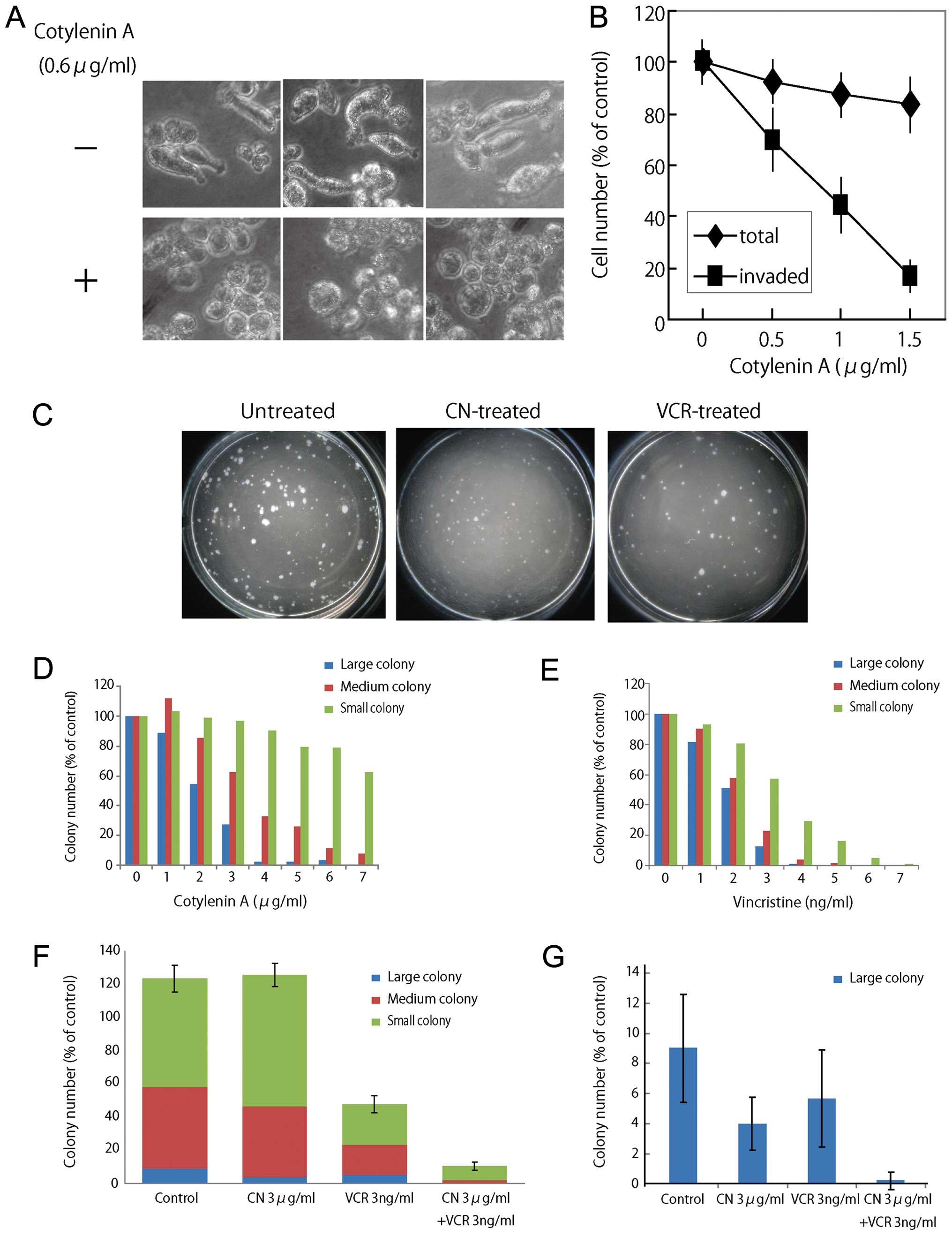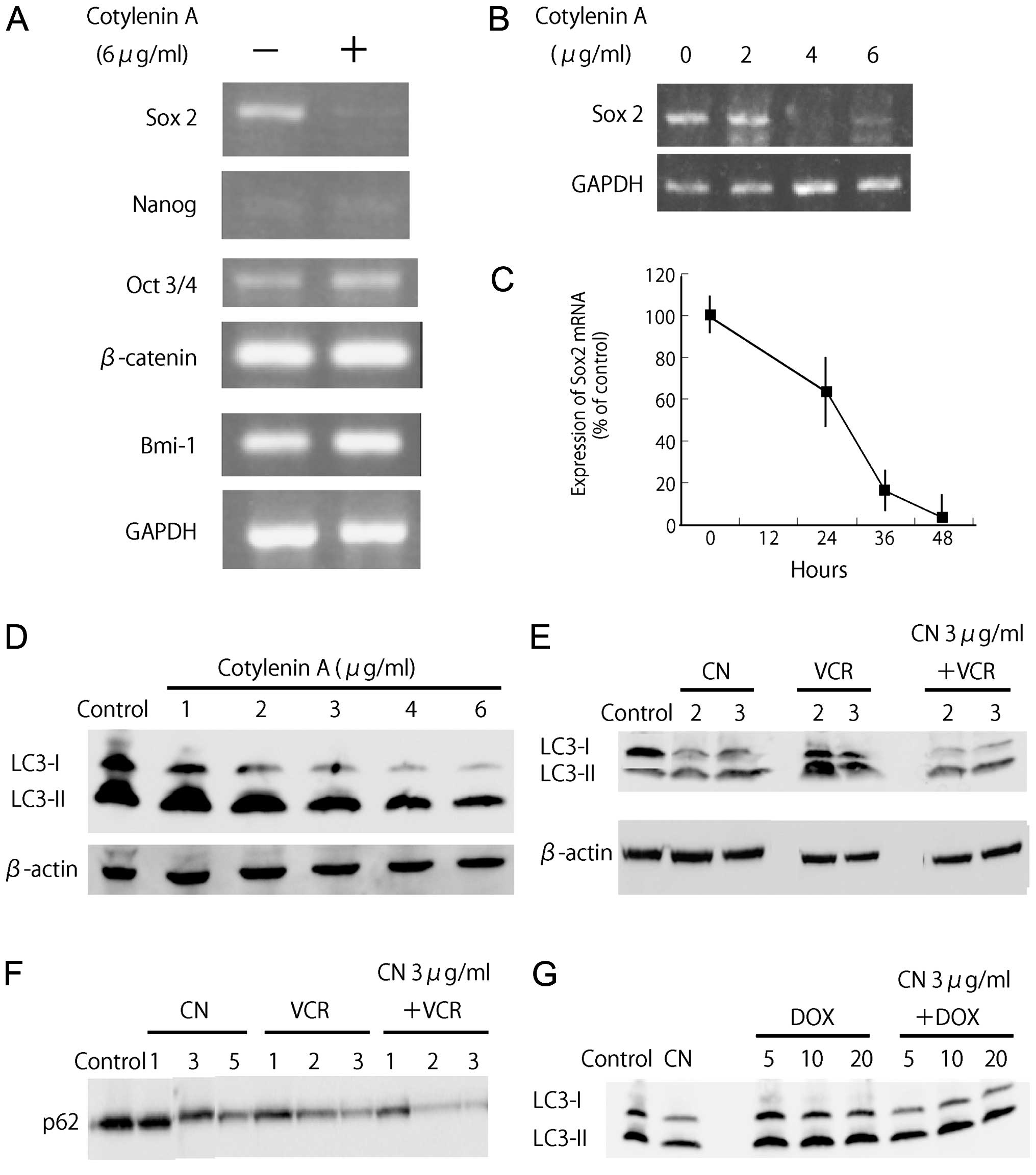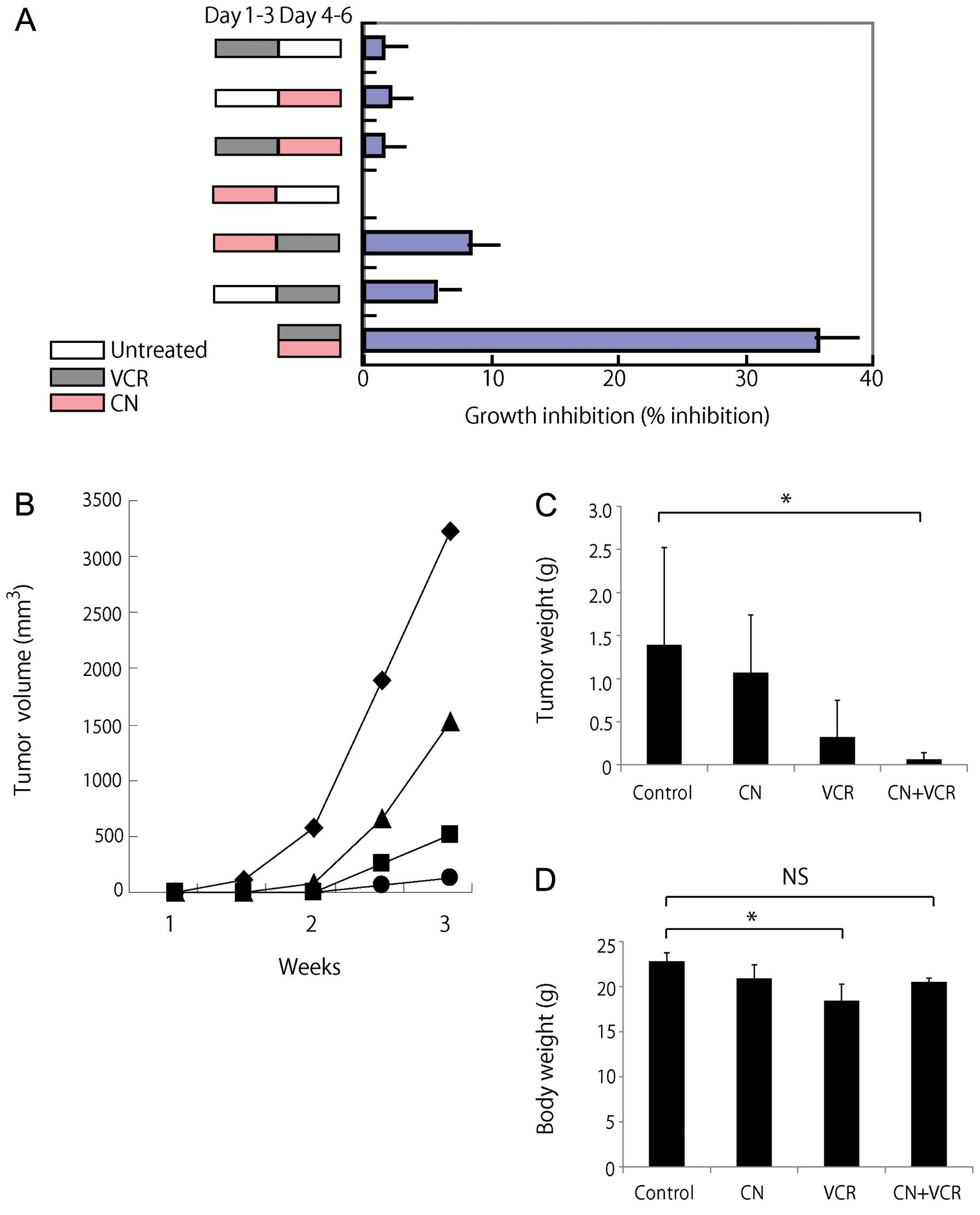Synergistic combination therapy with cotylenin A and vincristine in multiple myeloma models
- Authors:
- Published online on: February 9, 2015 https://doi.org/10.3892/ijo.2015.2882
- Pages: 1801-1809
Abstract
Introduction
Multiple myeloma is a malignant proliferative disease of plasma cells in the bone marrow. While drugs such as lenalidomide and bortezomib have improved survival, myeloma remains largely incurable. Efforts are underway to optimize existing chemotherapeutic strategies and discover new agents. It is important to control the disease in the long term while maintaining the patient’s quality of life because it is still difficult to cure. The development of less-cytotoxic agents would be desirable for this purpose.
Cotylenin A, which has a diterpenoid tricarbocyclic skeleton, has been shown to induce the differentiation of myeloid leukemia cell lines and leukemic cells isolated from acute myeloid leukemia patients in primary culture (1–3). Administration of cotylenin A significantly prolonged the survival of mice that had been inoculated with retinoid-sensitive and -resistant NB4 cells, and no appreciable adverse effects were observed in the experiments (4).
Combined treatment with IFNα and cotylenin A preferentially induced apoptosis in human lung cancer cells while sparing normal lung epithelial cells and significantly inhibited the growth of human lung cancer cells as xenografts without apparent adverse effects, suggesting that this combination may have therapeutic value in treating human cancer (5–7). These findings suggest that cotylenin A may be useful in the therapy for leukemia and some other malignancies.
In the present study, we examined the antitumor effects of cotylenin A and identified drugs that could be administered in combination with cotylenin A to inhibit the growth of myeloma cells to develop a novel therapeutic strategy against multiple myeloma.
Materials and methods
Cells and culture
Human multiple myeloma cell lines RPMI-8226, KMS-11, KMS-26, KMS-12 PE and KMS-12 BM were obtained from JCRB Cell Bank (Osaka, Japan), and cultured in RPMI-1640 supplemented with 10% fetal bovine serum. Matrigel-coated dishes were prepared according to the manufacturer’s instructions (BD Biosciences, San Jose, CA, USA).
Materials
Cotylenin A was purified from a stock ethyl acetate extract obtained from the culture filtrate of Cladosporium fungus sp. 501-7W by flash chromatography on silica gel with >99% purity (8). Vincristine and other anticancer agents, 3-(4,5-di-methylthiazol-2-yl)-2,5-diphenyltetrazolium bromide (MTT), and propidium iodide were purchased from Sigma-Aldrich (St. Louis, MO, USA). Anti-XIAP, anti-survivin and anti-LC3 monoclonal antibodies were purchased from Cell Signaling Technology (Danvers, MA, USA). Anti-P62 monoclonal antibody was obtained from MBL (Nagoya, Japan).
Assay of cell growth
The cells were seeded at 1×105 cells/ml in a 24-well multidish. After culture with or without the test compounds for indicated times, viable cells were examined by a modified MTT assay (9).
Annexin V binding assay
Cells were labeled with PE-labeled Annexin V (BD Biosciences) for 30 min on ice, as described previously (10). After staining, cells were washed and analyzed by flow cytometry (BD FACSCalibur, San Jose, CA, USA).
Flow cytometric analysis of cell cycle distribution
The cell cycle was analyzed using propidium iodide-stained nuclei (11). The histogram of DNA content was analyzed by flow cytometry (BD FACSCalibur) using CellQuest software (BD Immunocytometry Systems, San Jose, CA, USA) to determine the cell cycle distribution (sub-G1, G1, S and G2/M).
Protein profiler array
RPMI-8226 cells were treated with or without cotylenin A and/or vincristine for 48 h. All immuno detection steps were performed using a Proteome Profiler Array (R&D Systems, Minneapolis, MN, USA) in accordance with the manufacturer’s instructions. Briefly, the cells were collected and lysed in lysis buffer. The array was incubated overnight with the diluted lysates (500 μg/250 μl) at 4°C on a rocking platform shaker. Primary (reconstituted detection antibody cocktail) and secondary [streptavidin-horseradish peroxidase (HRP) (1:2000)] antibodies were added to each array.
Western blot analysis
Cells were packed after being washed with cold phosphate-buffered saline (PBS) and then lysed at a concentration of 1×107 cells/ml in lysis buffer (Wako, Osaka, Japan). Equal amounts of protein were separated on 10% SDS-polyacrylamide gels. The proteins were electrophoresed on gels and transferred to an Immobilon-P membrane (Millipore, Bedford, MA, USA) using rabbit anti-XIAP (1:1000) and rabbit anti-survivin (1:1000) antibodies. All Western blots shown are representative of at least 3 independent experiments.
Transwell chamber invasion assay
The invasiveness of RPMI-8226 cells was evaluated by a transwell chamber assay. Matrigel (50 μg/ml, BD Biosciences) was melted at 4°C, and diluted to 1:8 by serum-free RPMI-1640 medium. The upper side of the polycarbonate filter of the Transwell chamber was coated with matrigel. Cells (2×105) were suspended in 800 μl of serum-free medium that contained 1 mg/ml bovine serum albumin to maintain the osmotic pressure, and placed in the upper chamber. The lower chamber was filled with 10% serum-medium (1000 μl). Cells were then cultured for 24 h at 37 °C in 5% CO2. Cells on the upper surface of the filter were removed using a cotton swab. The invading cells on the lower surface of the filter were fixed with formaldehyde (4%) and stained with 0.1% crystal violet in 2% methanol. Invasiveness was determined by counting cells in five microscopic fields per well, and the extent of invasion was expressed as the average number of cells per microscopic field.
Colony-forming assay
Cells (1×104 per dish) were plated into 1.1 ml of a semisolid methylcellulose medium with 0.8% methylcellulose and 20% fetal bovine serum in triplicate for 14 days. A solution of 0.2 ml of PBS containing various concentrations of cotylenin A or vincristine was added to the semisolid medium. Colonies were photographed under an inverted microscope. Colonies in enlarged photographs were measured and counted. Colonies were classified as large (>0.7 mm in diameter), medium (0.4–0.7 mm) or small (0.2–0.4 mm).
Reverse transcription-polymerase chain reaction (RT-PCR)
Total RNA was extracted from cells using TRI reagent (Sigma-Aldrich). Total RNA (1 μg) was converted to first-strand cDNA primed with random hexamer in a reaction volume of 20 μl using an RNA PCR kit (Takara Bio, Tokyo, Japan), and 4 μl of this reaction mixture was used as a template in the polymerase chain reaction (9). The primers used were as previously described (12).
Transplantation of myeloma cells into SCID mice and treatment
Six-week-old female (Fox Chase SCID C.B-17/Icr-scid Jcl) mice were subcutaneously inoculated with 6×106 KMS-26 cells. The adjusted 6×107 cells/ml were mixed with an equal volume of Matrigel (BD Biosciences) and 0.2 ml of the mixture was subcutaneously injected into the lower back of each animal using a 26-gauge needle. Mice were given intraperitoneal injections of 0.2 ml of PBS with 0.5 mg/kg vincristine and/or 5 mg/kg cotylenin A three times per week for 3 weeks. The first treatment was given 4 days after the inoculation of tumor cells. Tumor volume was measured with vernier calipers. We performed experiments according to national legislation on laboratory animal protection and our protocol was approved by the animal ethics committee of Shimane University.
Statistical analysis
Pairs of data were compared using Student’s t-test. For the experiment in vivo, the significance of differences among the four groups was assessed using a one-way analysis of variance and the Kruskal-Wallis test. P-values of <0.05 were considered to reflect statistical significance.
Results
Combined effects of cotylenin A and various drugs on the growth of myeloma cells
Since IFNα has been shown to have beneficial effects in the treatment of multiple myeloma (13,14), and combined treatment with cotylenin A and IFNα synergistically inhibited growth both in vitro and in vivo in various human cancer cells (6,7), multiple myeloma might be a reasonable target for combined treatment with cotylenin A and IFNα. Therefore, we examined the anti-proliferative effects of cotylenin A and IFNα in 5 myeloma cell lines. RPMI-8226, KMS-12 PE and KMS-26 cells were highly sensitive to the combined treatment. However, KMS-12 BM cells did not respond to IFNα even in the presence of cotylenin A, and KMS-11 cells were less sensitive to the combined treatment. These results suggest that this treatment may be useful only in certain patients with multiple myeloma.
Next, we screened various anticancer agents with small molecules to identify the most potent drug with respect to its co-operative effect with cotylenin A on the growth of multiple myeloma cells. To measure the effects of various drugs on the growth of myeloma RPMI-8226 cells, the number of viable cells was determined by the MTT assay after 6 days of exposure to various concentrations of drugs with or without 2 μg/ml of cotylenin A. The growth-inhibiting effects of the drugs were examined by determining the concentrations of drugs required to reduce the cell number to one-half of that in untreated cells (IC50). While the sensitivity to anticancer agents, such as doxorubicin, camptotecin, cisplatin, 5-fluorouracil, methotrexate or gemcitabine, was not affected by cotylenin A, the sensitivity to vincristine and other microtubule-disturbing agents was significantly enhanced (Table I).
Table IPotentiation of the growth-inhibitory activities of various anticancer agents in RPM-I8226 myeloma cells by cotylenin A. |
Cotylenin A had synergistic effects with vincristine (Fig. 1A) and the results were confirmed by an isobologram analysis (15). Fig. 1B shows isoboles for the combination of vincristine with cotylenin A that were isoeffective (IC50: concentration of the drug required for 50% inhibition of cell growth) for inhibition of the proliferation of RPMI-8226 cells. These isoboles indicate that the combination of these drugs had synergistic effects. The synergistic effects of cotylenin A and vincristine were also observed in other myeloma cell lines, although the different myeloma cell lines had different sensitivities to vincristine (Fig. 1C–F).
Induction of apoptosis in RPMI-8226 cells treated with cotylenin A and vincristine
When RPMI-8226 cells were exposed to 2 ng/ml vincristine in the presence of cotylenin A for 4 days, a morphological analysis showed shriveled cells, chromatin condensation, nuclear fragmentation and cytoplasmic blebbing, although these morphological changes were hardly observed in cells treated with 2 ng/ml vincristine alone. The induction of apoptosis was confirmed by an analysis of the DNA histogram (cells in sub-G1 phase) and the expression of Annexin V (Table II, Fig. 2A). A proteome profiler analysis of myeloma cells was performed to elucidate the effects of the combined treatment on apoptotic pathways.
The expression of cleaved caspase-3 was increased in treatment with vincristine and further enhanced by cotylenin A (Fig. 2B). Significant alterations in protein expression were noted in cells treated with cotylenin A and vincristine: the levels of anti-apoptotic proteins such as cIAP, XIAP and survivin were markedly decreased (Fig. 2C). These changes were confirmed by Western blot analysis (Fig. 2D). The expression of anti-apoptotic proteins, Bcl-2 or Bcl-X, was hardly affected by treatment.
Morphologic changes and reduction of invasive activity in cells treated with cotylenin A
When RPMI-8226 cells were cultured on a Matrigel-coated dish, most of the cells had elongated shapes and were migrating. However, treatment with a low concentration of cotylenin A (0.6 μg/ml) induced morphological changes without inhibiting growth. Most of the treated cells had round shapes within 3 days (Fig. 3A). An invasion assay revealed that cotylenin A effectively inhibited the invasive activity of RPMI-8226 cells without inhibiting growth (Fig. 3B).
Inhibition of colony formation and expression of pluripotency-associated transcription factors by cotylenin A
A colony-forming assay indicated that cotylenin A preferentially inhibited the formation of large colonies whereas vincristine similarly inhibited the formation of colonies of different sizes (Fig. 3C–E). The combined treatment with cotylenin A and vincristine effectively suppressed colony formation by myeloma cells (Fig. 3F), and especially the formation of large colonies (Fig. 3G).
Since Wnt/β-catenin signaling molecules have been implicated in the maintenance of pluripotency-associated transcription factors (16), we evaluated the mRNA expression of β-catenin as well as the mRNA expression of pluripotency-associated transcription factor (Fig. 4A and B). Expression of Sox2 mRNA was significantly suppressed by treatment with cotylenin A. The reduction of Sox2 mRNA expression was observed within 24 h (Fig. 4C).
Effect of vincristine or doxorubicin on autophagy induced by cotylenin A
Autophagy is a survival pathway that is responsible for the breakdown of damaged organelles and protein aggregates, although there is an ongoing controversy regarding whether the autophagy pathway primarily represents a pro-survival or pro-cell death mechanism with cancer therapy (17). Microtubules are required for autophagosomal biogenesis and degradation, and vinca alkaloids disrupt autophagosome maturation/degradation by preventing the movement of autophagosomes and their fusion with lysosomes (18). Several studies have demonstrated that the treatment of cancers with agents that induce autophagy in combination with agents that block autophagosome maturation/degradation results in synergistic apoptotic cell death (19–21). Myeloma cells require a basal level of autophagy for survival and the pharmacologic or genetic inhibition of autophagy caused myeloma cells to die (22). Therefore, we examined the effects of vincristine and doxorubicin on autophagic processes to understand how cotylenin A preferentially sensitizes myeloma cells to vincristine.
As described above, treatment with cotylenin A alone inhibited cell growth in a concentration-dependent manner, but did not significantly induce apoptosis. Since cotylenin A might induce autophagy in RPMI-8226 cells, we examined the levels of LC3-I and -II in cells treated with cotylenin A. Upon the initiation of autophagy, LC3 relocates from the cytosol to autophagosome membranes, where it plays a role in autophagosome enlargement, and cytosolic LC3 (LC3-I, 18 kDa) undergoes C-terminal proteolytic processing to a 16 kDa isoform, LC3-II. Fig. 4D shows that cotylenin A reduced the accumulation of LC3-I in a dose-dependent manner. This finding suggests that cotylenin A induced autophagosomes. Vincristine also induced the accumulation of LC3-II, whereas doxorubicin hardly affected the accumulation of LC3-II (Fig. 4E and G). Cells treated with cotylenin A and vincristine showed a synergistic increase in the levels of LC3-II compared to those treated with either of the agents alone (Fig. 4E). A synergistic increase was not observed in cells treated with cotylenin A and doxorubicin (Fig. 4G). p62 protein is a marker for autophagic flux, since the autophagy pathway normally degrades this protein. The accelerated degradation of p62 protein was also found in response to the combination treatment (Fig. 4F). These results indicate that there is a significant difference between the autophagic responses to vincristine and doxorubicin.
Effects of pre- and post-treatment with cotylenin A and vincristine on the growth of myeloma cells
To determine whether simultaneous treatment gives the best results, we examined the effects of pre- and post-treatment with cotylenin A on the vincristine-induced inhibition of the growth of RPMI-8226 cells. The results may provide useful information regarding the best schedule for combined treatment with cotylenin A and vincristine against xenografts of human myeloma cells. For pretreatment, cells were treated with 2 μg/ml of cotylenin A for 3 days, washed in fresh medium, and incubated with 2 ng/ml of vincristine for 3 days. For posttreatment, cells were treated with 2 ng/ml of vincristine for 3 days and then with 2 μg/ml of cotylenin A. Fig. 5A shows that simultaneous treatment is more effective than pre- or post-treatment with cotylenin A, although pretreatment with cotylenin A gave better results than posttreatment. Similar results were obtained when other myeloma cells were treated with cotylenin A and vincristine.
Effects of cotylenin A and vincristine on in vivo growth of myeloma cells as xenografts
To determine the potential for cotylenin A in treating myeloma, we treated KMS-26 xenograft-bearing SCID mice with cotylenin A alone or in combination with vincristine. We treated mice with cotylenin A at 5 mg/kg body weight, as described previously (4,6). This dose of cotylenin A was well-tolerated without a loss of body weight. Cotylenin A alone inhibited the growth of KMS-26 xenograft tumors with a day 21 (end of treatment period) T/C value (the mean volume of xenograft tumor in treated mice/that in untreated control mice) of 76.8% (Fig. 5B and C). Our in vitro studies (Fig. 5A) suggest that simultaneous treatment with cotylenin A and vincristine is more effective therapeutically than treatment with vincristine alone. Therefore, we examined the combined effects of cotylenin A and vincristine on the in vivo growth of KMS-26 cells (Fig. 5B and C). Vincristine alone greatly inhibited tumor growth with a T/C value of 22.7%. Combined treatment caused tumor stasis at day 21 with a T/C value of 4.6 %. In this model, cotylenin A exhibited single-agent activity in xenografts of KMS-26 cells, along with increased antitumor effects in combination with vincristine. A statistical analysis revealed that the difference was significant (P<0.05, versus control). The effects of single-agent treatments were not statistically significant in this experiment among the 4 groups. Vincristine caused significant decrease in the body weight of the mice. However, the weight loss in the combined-treated group was lower than that in mice treated with vincristine alone (Fig. 5D).
Discussion
The phenotypes of cancer stem cells in multiple myeloma are still controversial (23,24). In the present study, we demonstrated that cotylenin A preferentially inhibited the population that formed large colonies, suggesting that cells have high self-renewal activity. The pluripotency-associated transcription factor Sox2 was effectively down-regulated by treatment with cotylenin A. Expression of Sox2 was important for the development of tumors, as shown in vivo experiments. Spisek et al reported that Sox2 was highly expressed in the clonogenic compartment of plasma cells and that anti-Sox2 T cells help to prevent disease progression in patients with monoclonal gammopathy (25). These results suggest that cotylenin A is a useful drug for cancer stem cell-targeted therapy against multiple myeloma.
Multiple myeloma remains incurable for the vast majority of patients, which suggests that the cancer stem cells that mediate relapse are relatively resistant to chemotherapy. Cotylenin A effectively inhibits clonogenic growth and the expression of Sox2 in myeloma cells. The inhibition of clonogenic growth was coupled with accelerated differentiation of the cells into mature CD138+ cells (26). Cotylenin A effectively and concentration-dependently decreased CD138− cells in an RPMI-8226 cell population (data not shown). The sensitivity to vincristine was effectively enhanced by cotylenin A, and combined treatment with cotylenin A and vincristine significantly inhibited tumor growth in xenografts. Cotylenin A had no apparent effects on mice (body weight or behavior), and reduced the vincristine-induced toxicity in tumor-bearing mice. Vincristine is frequently used for the treatment of multiple myeloma (27,28). These results suggest that the combination of cotylenin A and vincristine could be useful for the treatment of multiple myeloma.
While cotylenin A significantly enhanced the sensitivity to vincristine and other microtubule-disturbing agents, cotylenin A did not affect the sensitivity to other anticancer agents such as doxorubicin, camptotecin, cisplatin, 5-fluorouracil, methotrexate and gemcitabine. These differences might be attributed to the effects on autophagic responses. Cotylenin A and vincristine concentration-dependently induced autophagy, and combined treatment with cotylenin A and vincristine further induced autophagy (formation of LC3-II and degradation of p62 protein). However, doxorubicin did not affect the autophagic responses, and did not enhance the autophagy induced by cotylenin A. Combined treatment with vincristine and cotylenin A also induced apoptosis (activation of caspase-3, accumulation of subG1 fraction and induction of Annexin V). Myeloma cells exhibit low-level autophagy under basal conditions, and uncontrolled autophagy may reduce cellular viability under some circumstances (29). Further studies will be needed to better understand the cell death induced by vincristine plus cotylenin A.
A receptor of fusicoccins, including cotylenin A, has been reported to be a member of a family of 14-3-3 proteins that are found in a huge array of signaling and regulatory pathways (30). The 14-3-3 proteins bind to discrete phosphoserine-containing motifs present in many signaling molecules. The 14-3-3 proteins are associated with dynamic nucleocytoplasmic shuttling. However, further studies will be needed to explain how the sensitization to vincristine is related to the effects of cotylenin A on the 14-3-3 signaling pathway.
The administration of cotylenin A significantly prolonged the survival of mice that had been inoculated with cells of the human promyelocytic leukemia cell line NB4 (4). Cotylenin A co-operatively inhibited tumor growth in xenografts with IFNα (6), rapamycin (9) or cetuximab (31). Treatment with cotylenin A had no apparent adverse effects on mice, and reduced the adverse effects of vincristine on tumor-bearing mice. A novel fusicoccin derivative, closely related to cotylenin A, significantly inhibited the growth of pancreatic cancer MIAPaCa-2 cells as xenografts without apparent adverse effects (32). These results suggest that 14-3-3 proteins may be novel targets in cancer therapy.
In conclusion, we found that cotylenin A and vincristine synergistically inhibited the growth of and induced apoptosis in myeloma cells in vitro and in vivo. Our results suggest that the combination of cotylenin A and vincristine may have therapeutic value in treating multiple myeloma.
References
|
Yamamoto-Yamaguchi Y, Yamada K, Ishii Y, Asahi KI, Tomoyasu S and Honma Y: Induction of the monocytic differentiation of myeloid leukaemia cells by cotylenin A, a plant growth regulator. Br J Haematol. 112:697–705. 2001. View Article : Google Scholar : PubMed/NCBI | |
|
Yamada K, Honma Y, Asahi KI, Sassa T, Hino KI and Tomoyasu S: Differentiation of human acute myeloid leukaemia cells in primary culture in response to cotylenin A, a plant growth regulator. Br J Haematol. 114:814–821. 2001. View Article : Google Scholar : PubMed/NCBI | |
|
Honma Y and Cotylenin A: Cotylenin A - a plant growth regulator as a differentiation-inducing agent against myeloid leukemia. Leuk Lymphoma. 43:1169–1178. 2002. View Article : Google Scholar : PubMed/NCBI | |
|
Honma Y, Ishii Y, Sassa T and Asahi K: Treatment of human promyelocytic leukemia in the SCID mouse model with cotylenin A, an inducer of myelomonocytic differentiation of leukemia cells. Leuk Res. 27:1019–1025. 2003. View Article : Google Scholar : PubMed/NCBI | |
|
Honma Y and Akimoto M: Therapeutic strategy using phenotypic modulation of cancer cells by differentiation-inducing agents. Cancer Sci. 98:1643–1651. 2007. View Article : Google Scholar : PubMed/NCBI | |
|
Honma Y, Ishii Y, Yamamoto-Yamaguchi Y, Sassa T and Asahi K: Cotylenin A, a differentiation-inducing agent, and IFN-alpha cooperatively induce apoptosis and have an antitumor effect on human non-small cell lung carcinoma cells in nude mice. Cancer Res. 63:3659–3666. 2003.PubMed/NCBI | |
|
Honma Y, Kasukabe T, Yamori T, Kato N and Sassa T: Antitumor effect of cotylenin A plus interferon-α: Possible therapeutic agents against ovary carcinoma. Gynecol Oncol. 99:680–688. 2005. View Article : Google Scholar : PubMed/NCBI | |
|
Sassa T, Tojyo T and Munakata K: Isolation of a new plant growth substance with cytokinin-like activity. Nature. 227:3791970. View Article : Google Scholar : PubMed/NCBI | |
|
Kasukabe T, Okabe-Kado J, Kato N, Sassa T and Honma Y: Effects of combined treatment with rapamycin and cotylenin A, a novel differentiation-inducing agent, on human breast carcinoma MCF-7 cells and xenografts. Breast Cancer Res. 7:R1097–R1110. 2005. View Article : Google Scholar | |
|
Ishii Y, Hori Y, Sakai S and Honma Y: Control of differentiation and apoptosis of human myeloid leukemia cells by cytokinins and cytokinin nucleosides, plant redifferentiation-inducing hormones. Cell Growth Differ. 13:19–26. 2002.PubMed/NCBI | |
|
Niitsu N, Higashihara M and Honma Y: The catalytic DNA topoisomerase II inhibitor ICRF-193 and all-trans retinoic acid cooperatively induce granulocytic differentiation of acute promyelocytic leukemia cells: Candidate drugs for chemodifferentiation therapy against acute promyelocytic leukemia. Exp Hematol. 30:1273–1282. 2002. View Article : Google Scholar : PubMed/NCBI | |
|
Ikegame A, Ozaki S, Tsuji D, et al: Small molecule antibody targeting HLA class I inhibits myeloma cancer stem cells by repressing pluripotency-associated transcription factors. Leukemia. 26:2124–2134. 2012. View Article : Google Scholar : PubMed/NCBI | |
|
Quesada JR, Alexanian R, Hawkins M, Barlogie B, Borden E, Itri L and Gutterman JU: Treatment of multiple myeloma with recombinant alpha-interferon. Blood. 67:275–278. 1986. | |
|
Mandelli F, Avvisati G, Amadori S, et al: Maintenance treatment with recombinant interferon alfa-2b in patients with multiple myeloma responding to conventional induction chemotherapy. N Engl J Med. 322:1430–1434. 1990. View Article : Google Scholar : PubMed/NCBI | |
|
Chou TC and Talalay P: Quantitative analysis of dose-effect relationships: The combined effects of multiple drugs or enzyme inhibitors. Adv Enzyme Regul. 22:27–55. 1984. View Article : Google Scholar : PubMed/NCBI | |
|
Marson A, Foreman R, Chevalier B, Bilodeau S, Kahn M, Young RA and Jaenisch R: Wnt signaling promotes reprogramming of somatic cells to pluripotency. Cell Stem Cell. 3:132–135. 2008. View Article : Google Scholar : PubMed/NCBI | |
|
White EJ, Martin V, Liu JL, Klein SR, Piya S, Gomez-Manzano C, Fueyo J and Jiang H: Autophagy regulation in cancer development and therapy. Am J Cancer Res. 1:362–372. 2011.PubMed/NCBI | |
|
Xie R, Nguyen S, McKeehan WL and Liu L: Acetylated microtubules are required for fusion of autophagosomes with lysosomes. BMC Cell Biol. 11:892010. View Article : Google Scholar : PubMed/NCBI | |
|
Marimpietri D, Brignole C, Nico B, et al: Combined therapeutic effects of vinblastine and rapamycin on human neuroblastoma growth, apoptosis, and angiogenesis. Clin Cancer Res. 13:3977–3988. 2007. View Article : Google Scholar : PubMed/NCBI | |
|
Zhou Q, Lui VW, Lau CP, Cheng SH, Ng MH, Cai Y, Chan SL and Yeo W: Sustained antitumor activity by co-targeting mTOR and the microtubule with temsirolimus/vinblastine combination in hepatocellular carcinoma. Biochem Pharmacol. 83:1146–1158. 2012. View Article : Google Scholar : PubMed/NCBI | |
|
Adiseshaiah PP, Clogston JD, McLeland CB, et al: Synergistic combination therapy with nanoliposomal C6-ceramide and vinblastine is associated with autophagy dysfunction in hepatocarcinoma and colorectal cancer models. Cancer Lett. 337:254–265. 2013. View Article : Google Scholar : PubMed/NCBI | |
|
Hoang B, Benavides A, Shi Y, Frost P and Lichtenstein A: Effect of autophagy on multiple myeloma cell viability. Mol Cancer Ther. 8:1974–1984. 2009. View Article : Google Scholar : PubMed/NCBI | |
|
Agarwal JR and Matsui W: Multiple myeloma: A paradigm for translation of the cancer stem cell hypothesis. Anticancer Agents Med Chem. 10:116–120. 2010. View Article : Google Scholar : PubMed/NCBI | |
|
Boucher K, Parquet N, Widen R, Shain K, Baz R, Alsina M, Koomen J, Anasetti C, Dalton W and Perez LE: Stemness of B-cell progenitors in multiple myeloma bone marrow. Clin Cancer Res. 18:6155–6168. 2012. View Article : Google Scholar : PubMed/NCBI | |
|
Spisek R, Kukreja A, Chen LC, et al: Frequent and specific immunity to the embryonal stem cell-associated antigen SOX2 in patients with monoclonal gammopathy. J Exp Med. 204:831–840. 2007. View Article : Google Scholar : PubMed/NCBI | |
|
Leung-Hagesteijn C, Erdmann N, Cheung G, Keats JJ, Stewart AK, Reece DE, Chung KC and Tiedemann RE: Xbp1s-negative tumor B cells and pre-plasmablasts mediate therapeutic proteasome inhibitor resistance in multiple myeloma. Cancer Cell. 24:289–304. 2013. View Article : Google Scholar : PubMed/NCBI | |
|
Kumar A, Galeb S and Djulbegovic B: Treatment of patients with multiple myeloma: An overview of systematic reviews. Acta Haematol. 125:8–22. 2011. View Article : Google Scholar | |
|
Suzuki K: Current therapeutic strategy for multiple myeloma. Jpn J Clin Oncol. 43:116–124. 2013. View Article : Google Scholar : PubMed/NCBI | |
|
Galluzzi L, Vitale I, Abrams JM, et al: Molecular definitions of cell death subroutines: Recommendations of the Nomenclature Committee on Cell Death 2012. Cell Death Differ. 19:107–120. 2012. View Article : Google Scholar : | |
|
Oecking C, Eckerskorn C and Weiler EW: The fusicoccin receptor of plants is a member of the 14-3-3 superfamily of eukaryotic regulatory proteins. FEBS Lett. 352:163–166. 1994. View Article : Google Scholar : PubMed/NCBI | |
|
Molzan M, Kasper S, Röglin L, et al: Stabilization of physical RAF/14-3-3 interaction by cotylenin A as treatment strategy for RAS mutant cancers. ACS Chem Biol. 8:1869–1875. 2013. View Article : Google Scholar : PubMed/NCBI | |
|
Kawakami K, Hattori M, Inoue T, et al: A novel fusicoccin derivative preferentially targets hypoxic tumor cells and inhibits tumor growth in xenografts. Anticancer Agents Med Chem. 12:791–800. 2012. View Article : Google Scholar : PubMed/NCBI |



